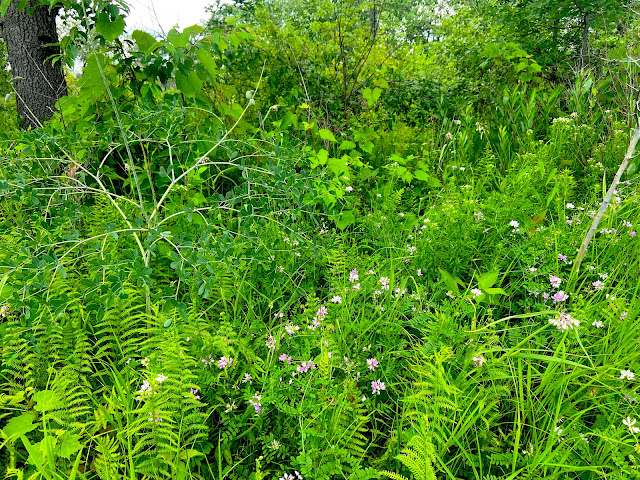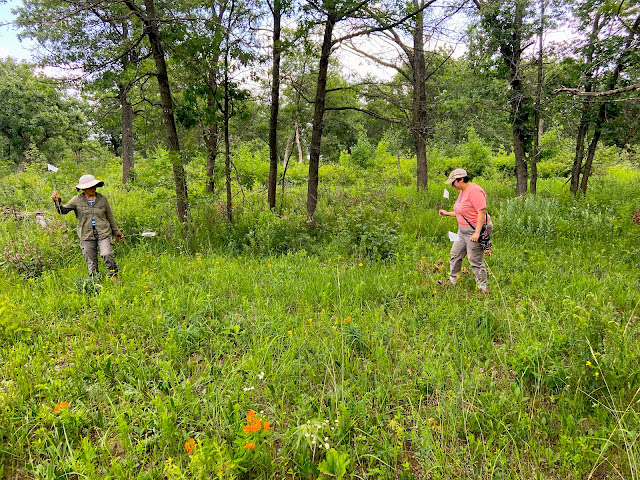Reports:
We battled the twin evils: sweet clover and crown vetch. For our first miracle, on July 22, nine people pulled the invasive clover for three hours; seven trained and-increasingly-expert volunteers sprayed the nasty crown vetch.
Upcoming events:
We're now meeting at Illinois Beach Nature Center at 9 AM every Saturday to work together until noon (or as long as you can stay) to do the important work of the day. Those whose schedules allow are also meeting on Thursday from 9 AM to noon.
News:
In addition to the upcoming festivities ...
... we can report that endangered piping plovers have been restored to Illinois Beach - though exactly where is a secret. Don't try to find them. They're just chicks. Very vulnerable until they're older. (See Tribune article, below.)
First, we faced the horror of malignant invasives, in all their ugliness:
 |
| Here's what crown vetch looks like when it's just starting its nasty rampage. The big plant at top left is white false indigo. Many shorter species are already gone. |
 |
| Here, two of Saturday's volunteer leaders, Ashley Wold and Eriko Kojima, are placing white flags to mark crown vetch patches. The flags will help us to recognize the evil vetch at first. Soon we'll all be good at finding even the sneaky-est little infestations. |
 |
| Here's the other killer invasive ... white sweet clover. Its roots pull out of the sandy soil easily on these Illinois Beach savanna dunes ... but many hands are needed to get it all. |
 |
| Here Ashley is tying red flagging to mark a patch of sweet clover ... ... while Eriko looks for more vetch to flag. |
Another message is carried by all those brown leaves in the photo above. They are evidence of a successful recent burn. The dead oak leaves are on trees that were too dense for a thriving savanna, because of too little fire. The leaves died because the damaged bark couldn't maintain them. With repeated burns, some of the over-dense areas will recover natural structure and diversity. We volunteers have offered to help to Melissa Grycan with future burns, and she said she'd be super happy to have the help.
Melissa is the dedicated Illinois DNR biologist with ecological management responsibility for this preserve (along with many other Nature Preserves owned by the Illinois Department of Natural Resources). There are vastly more needs in all these preserves than she can handle alone. We the Friends - just-now-on-Saturday-having-our-first-public-work-event-here - are honored to work with her on this highly important challenge.
For more info about future plans of this new group, contact the Friends. Or for that matter, if you're good at it, help us establish more and better outreach, and make more and better plans. This important mission deserves the skills and smarts of a lot of good folks.
Plover News
Another dedicated biologist has been hard at work too. Brad Semel is busy restoring and protecting the restoration of some amazing birds to Illinois Beach. See the Chicago Tribune article, below:



The method I described in comments on the post “Crown Vetch - How to Combat an Evil” would be best near white false indigo, wild lupine, or other plants that Transline can kill.
ReplyDeleteThe method I described in comments on the post “Crown Vetch - How to Combat an Evil” would be best near white false indigo, wild lupine, prairie dock, and other plants that Transline can kill.
ReplyDelete